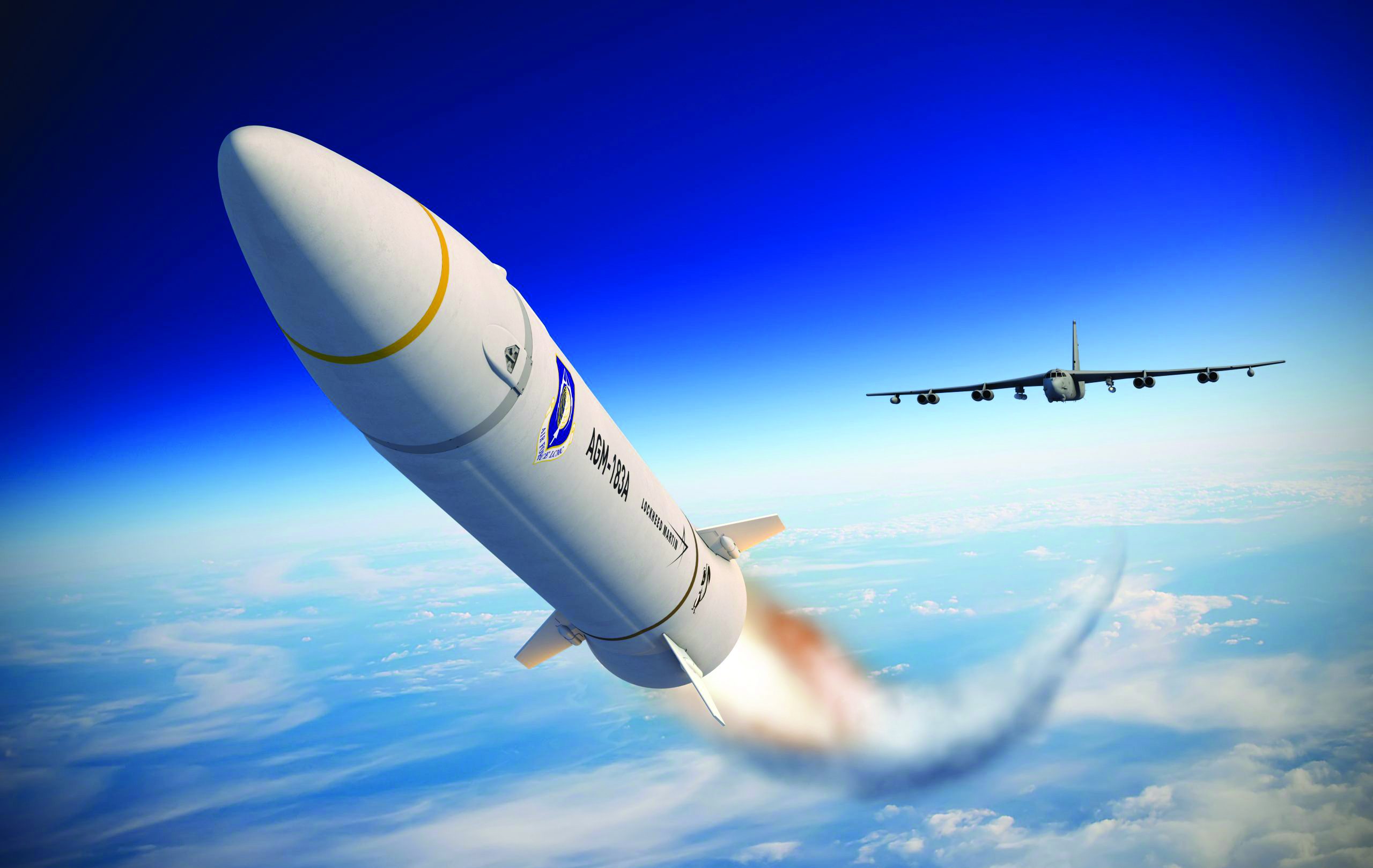On May 16, 2022, the US Air Force announced that it had successfully tested a hypersonic weapon that flies at Mach 5 (five times the speed of sound).
This development comes after Washington’s failure to keep up with Russia and China in producing this type of missile for four years.

Basic observations
The recent American tests come after a number of failed attempts, especially after Washington froze the hypersonic missile production program, believing that current technology isn’t advanced enough for the development of such missiles, before realizing that Russia and China had become more advanced in this field, and all these circumstances can be clarified as follows:
1- Three failed US tests: The success of the first US hypersonic missile, the AGM-183A Air-Launched Rapid Response Weapon (AGM-183A ARRW), came on June 14, 2022, after more than a year of program setbacks.
The missile failed three booster flight tests in 2021, failing to leave the B-52 bomber in April 2021, and in July, the missile managed to separate from the launcher, but its engine failed to work, and therefore failed to reach its target.
During the third test in December 2021, the failure was repeated, as a glitch occurred before the launch of the missile, which prompted the launcher to return to the base without launching it, and the reasons for this were not published, which later led the Air Force to withdraw funds allocated to the purchase of the missile from budget requests for 2022 and 2023.
It should be noted that the United States has made continuous efforts in this regard since the eighties of the last century, but it stopped the program because it believed that the current technology is insufficient to overcome the technical problems facing the production of such hypersonic missiles, such as propulsion problems, However, Russia’s success in carrying out the first known test of a hypersonic missile in 2018, prompted Washington to revive its projects in this framework, to catch up with Russia almost 4 years later, specifically in the first half of 2022.

2- A Russian-Chinese precedent: Since 2018, Russia and China have been able to carry out successful tests of hypersonic missiles, which entered service the following year, and in October 2019, China displayed the “Dongfeng-17” medium-range hypersonic missile with a hypersonic warhead with a range of 2,500 km during a military parade marking the 70th anniversary of the founding of the People’s Republic of China.

The Russian “Sarmat” (Satan) missile can also cross the North and South Poles, and there are plans to equip it with the “Avangard” hypersonic combat warhead powered by a nuclear engine, and notably, both the Chinese and Russian missiles can cross the Antarctic, that is, avoid the American missile shield systems, which protect the country from strikes directed from the north, not the south.
Strategic aspects
The American tests aim to confirm that Washington has caught up with Russia and China in the field of producing this type of advanced missiles, and the restoration of nuclear deterrence with them, although the Russian-Chinese superiority still exists, which can be detailed as follows:
1- Restoring the nuclear deterrence: Washington is well aware that Russia and China have managed to develop hypersonic missiles that have violated the existing nuclear deterrence equation between the United States and the two countries.
Although this possibility remains theoretical, US officials have voiced it and General John Hyten, former vice chairman of the Joint Chiefs of Staff, described the pace at which the Chinese military is developing its capabilities as “astounding”, warning that one day it might be china that has the ability to launch a surprise nuclear attack on the United States.
Hence, Washington’s start to develop hypersonic missiles will help it restore nuclear deterrence with Moscow and Beijing, and in the context of the ongoing war in Ukraine, Washington will appear as a nuclear power equivalent to Russia, not less capable than it, given that in any case, Washington will not enter a direct war against Russia, however, it helps Washington assert its prestige in front of its NATO allies, and that it cannot fail to defend them, as long as its nuclear and missile capabilities are equivalent to Russia.
2- Existing Russian supremacy: Russia is considered the most advanced country in the field of hypersonic missile development, followed by China, which is developing this technology at an accelerating pace, and despite the recent success of the American tests, it still suffers from a clear lag behind Russia and China, given that the two countries already have hypersonic weapons in service, while Washington is still in the testing phase.
The Russian Northern Fleet has tested the launch of about ten new hypersonic zircon missiles on board a frigate and two other missiles from a submarine, and these tests succeeded.
Another hypersonic missile, the Kingalo Avangard, has already entered service in Russia. It is not much different for China, which has several hypersonic missiles.

Russian supremacy
If Washington succeeded in testing a hypersonic missile with a speed of Mach 5, the Russian Zircon missile has a speed of about Mach 9, and the Kinzhal missile has a speed of Mach 10, while the Russian Avangard missile is capable of reaching speeds of about Mach 27, which means that there is already a Russian advantage in this framework.
Moscow also confirmed on March 19 and 20, 2022 that its forces used two hypersonic missiles in Ukraine, the first targeting a fuel depot in the south, and the second a missile and ammunition depot located underground near Ivano-Frankivsk in western Ukraine, which is the first known use in real combat conditions.
The United States sought to downplay the importance of this operation and its strategic repercussions, as the US Secretary of Defense, Lloyd Austin, himself commented on the Russian missile use, and stressed that the hypersonic missiles that Russia says it used to destroy military targets in Ukraine “make no difference” in the confrontation with the Ukrainian army, in an attempt to confirm that the Russian military superiority in Ukraine will not change the current balance of power on the ground significantly.
Although the Russian hypersonic missiles used were aimed at strengthening Russia’s nuclear superiority at the expense of the United States, and deterring NATO countries from escalation against Russia in the conflict over Ukraine, especially since Western countries have not yet been able to develop any air defense systems capable of monitoring, let alone intercepting hypersonic missiles.

On the other hand, the development of air defense systems against hypersonic missiles is also very difficult, given that this type of missile flies at a speed exceeding five times the speed of sound, meaning that it can maneuver and move at speeds ranging between 5 and 25 thousand kilometers per hour or between one and five miles per second, and they fly at exceptional altitudes, ranging from a few tens of kilometers to 100 kilometers.
These characteristics of high speed, maneuverability, and varying altitudes represent a major challenge for any defense system. It has the ability to make unlimited maneuvers, change direction and fly in an irregular path, so its targets cannot be predicted until the last minutes before impact.
Air Force General John Hyten, the United States’ top nuclear commander, confirmed that the United States lacked “any defense that could prevent the use” of a hypersonic weapon against it.

Despite these enormous challenges, Russia has once again been able to develop the first known air defense system to intercept this type of missile, which was explicitly confirmed by Russian President Vladimir Putin in June 2020, when he confirmed that Russia would “develop the means to counter hypersonic weapons within the next five years, it will also precede the world in developing this type of air defense systems.
This was achieved when the Russian Deputy Prime Minister, Yuri Borisov, said in May 2022 that the S-500 air defense system had entered service in the Russian army, a surface-to-air missile system with a range of 600 km, designed to intercept and destroy ballistic missiles, ICBMs, hypersonic cruise missiles and stealth aircraft.
Although the Russian announcement may be viewed with suspicion because it comes within the framework of the Russian-Ukrainian war, and the desire to confirm Russian control over Ukrainian airspace, and deter Washington from trying to send American fighters to dispute Russian control over Ukraine, the completion of tests on this system in June 2021 successfully, lends credibility to Russian claims.
Of course, it will take the United States many more years to develop anti-hypersonic air defense systems similar to those produced by Moscow, which confirms the continued superiority of this type of Russian weapon over its American counterpart.
General Mark Milley, Chairman of the Joint Chiefs of Staff, acknowledged the partial decline in American supremacy, in his speech on May 21 to graduating students from the US Military Academy at West Point, warning that “Whatever progress gap we have enjoyed militarily over the past 70 years, it is closing quickly.”
Adding that America is no longer the undisputed global power, as it is “being tested in Europe by the Russian military operation in Ukraine.”

Perhaps what confirms that the United States is still in the initial stages of developing hypersonic weapons is its announcement, in April 2022, that it will cooperate with Britain and Australia on developing hypersonic weapons and “electronic warfare capabilities” within the framework of the new, purposeful “Ocos” tripartite alliance to face China.
Conclusion
In conclusion, it can be said that the United States is still at the beginning of producing hypersonic missiles, which would enable it to try to catch up with Russia and China and restore nuclear deterrence with them.
However, it is clear that Washington will take time to develop hypersonic missiles capable of reaching the level of development reached by the Russian and Chinese hypersonic missiles, not to mention the development of anti-air defense systems.
By: Dr. Shadi Abdel Wahab (military researcher and strategist)














